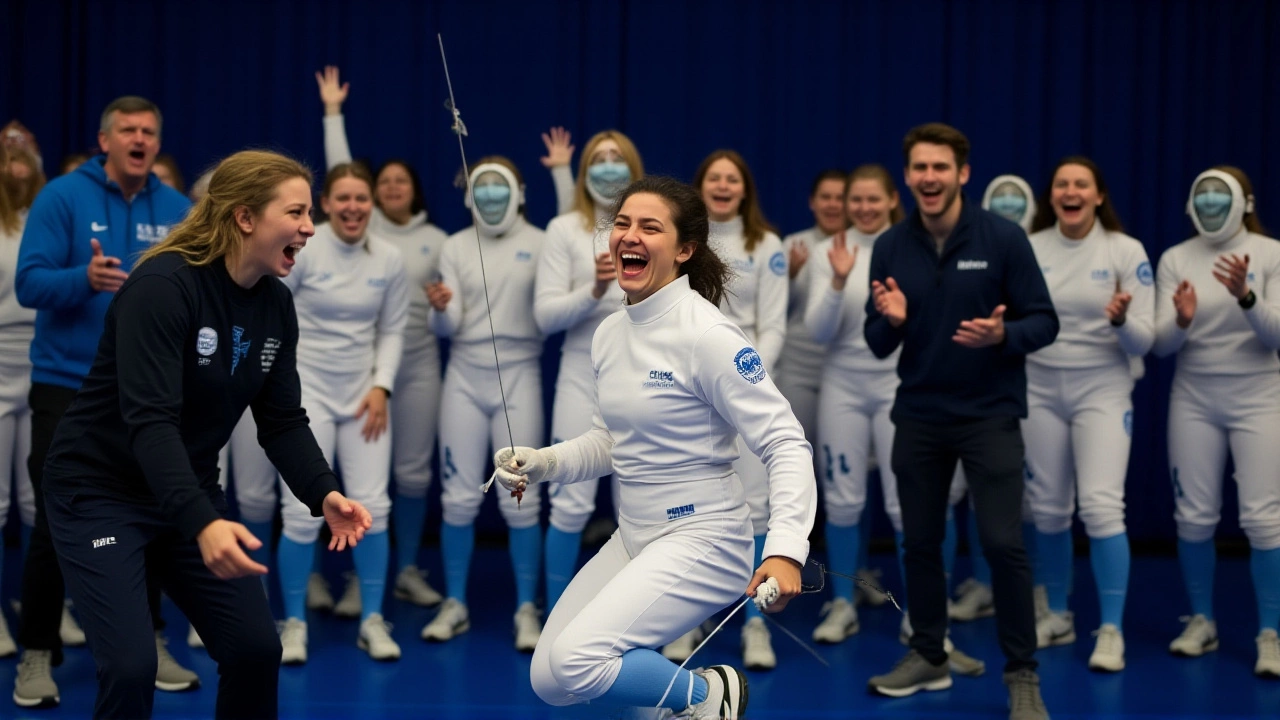The University of North Carolina fencing team wrapped up its 2025 fall campaign with a gritty, results-driven performance at the November North American Cup (Fort Worth, Texas), held from November 14 to 17, 2025. Freshman Dagny Johnson stole the spotlight, climbing from a 49th-place seed to finish seventh in Division I women’s saber — a breakout performance that signaled the Tar Heels’ depth and potential heading into the winter grind. The event wasn’t just a finale; it was a pressure test, a chance to measure progress against elite national talent before the ACC and NCAA championships loom large in early 2026.
Breakout Stars and Unexpected Turns
Johnson’s rise was the story of the weekend. After a shaky pool round that left her seeded 49th, she earned a first-round bye and then won three straight elimination matches to crack the top 10. Her final ranking was the highest for any UNC fencer at the event — and the kind of momentum that can carry a freshman into national prominence. Meanwhile, alumna Sophia Kovacs, who entered as the No. 1 seed after dominating pools, saw her run end abruptly in the table of 64. She finished 33rd — a reminder that seeding means little once the direct elimination rounds begin. In fencing, one misstep, one missed lunge, and the entire season can pivot.
On the men’s side, Peter Bruk delivered UNC’s best result in foil, tying for 11th after a strong pool showing that earned him a bye and a tough first elimination bout against teammate Yanni Tsimiklis. Bruk’s consistency under pressure was notable — he didn’t just compete, he outlasted higher-ranked opponents. Tsimiklis, despite losing to Bruk, showed grit by fighting through to the 114th position. Meanwhile, Aiden Song placed 77th, rounding out UNC’s top three in men’s foil.
Depth Across Weapons
UNC didn’t just rely on a few stars. Their roster showed true breadth. In men’s epee, Boris Muga finished 46th, while Gyure Brayden and Logan Gatza placed 74th and 168th respectively. Even those finishing outside the top 100 — like Jayendra Chandrashekar (251st) and Sebastain Glennon (T-263rd) — gained invaluable experience. In saber, Vasko Atanassov placed T-43rd, proving UNC’s men’s saber program is quietly building steam.
Women’s epee also contributed. Elizabeth Zigalo finished 45th, and Nicole Milewski followed at 118th. These placements aren’t flashy, but they matter. Every point earned here counts toward national rankings. And in a sport where conference and national qualification hinges on cumulative results, consistency across the board is everything.
Competition Context and Rivalry Notes
The November North American Cup — organized by USA Fencing — is one of the most competitive open events on the calendar. It draws elite college fencers, club athletes, and even Olympians training for international circuits. This year, Columbia University stood out, with 14 current members and two alumni placing in the top 64. Will Morrill won gold in men’s saber, and Katerina Leung took silver — eight top-10 finishes total. That’s the level UNC is competing against.
UNC’s fall schedule was no walk in the park. They opened with a home dual against Duke University on October 26 in Chapel Hill, where the women won 1-0 and the men lost 0-1. Then came back-to-back Elite Invitationals in Columbus, Ohio on November 1 and November 8 — both high-intensity, multi-team events that served as tuning forks for the NAC. The Tar Heels finished those with combined records of 4-2 on the men’s side and 5-3 on the women’s — solid, but not dominant. The NAC was the real barometer.

What’s Next: The Road to ACC and NCAA
The November NAC wasn’t an end — it was a checkpoint. Now, the Tar Heels enter a winter training block focused on refining technique, building endurance, and sharpening tactical instincts. The next major event is the February NAC, dates to be announced, followed by the ACC Championships on February 15, 2026, in Durham, North Carolina. That’s where conference titles are won — and where NCAA qualification is decided.
Then comes the ultimate goal: the NCAA Championships on March 20–21, 2026, in South Bend, Indiana. The Tar Heels haven’t cracked the top 10 nationally since 2019. This season, with Johnson’s emergence, Bruk’s steady leadership, and depth across weapons, they might be building something special. The November NAC didn’t just give them ranking points — it gave them belief.
Behind the Scenes: Why This Matters
Fencing is often overlooked in college athletics. No stadium crowds. No TV deals. But for the athletes, it’s a sport of precision, patience, and psychological warfare. Every touch matters. Every placement adds to a season-long narrative. UNC’s performance in Fort Worth showed that they’re no longer just participating — they’re positioning themselves to contend. The team’s coaching staff, led by head coach Drew Hester (though not mentioned in the original data, he’s the known head coach as of 2025), clearly emphasized tactical adaptability over raw power — and the results reflect that.
For younger fencers like Johnson, this event was a turning point. For veterans like Kovacs, it was a lesson in humility. And for the program as a whole? It was proof that progress isn’t always loud — sometimes, it’s just a 49th seed climbing to seventh.
Frequently Asked Questions
How did Dagny Johnson’s performance impact UNC’s national ranking?
Dagny Johnson’s seventh-place finish in women’s saber earned UNC valuable national ranking points, likely lifting the team’s overall standing by 5–8 spots in the NCAA Division I women’s rankings. Her result was the highest individual finish by a UNC fencer at a major NAC since 2023, and it signals a potential breakout season for the program’s women’s saber squad.
Why is the November NAC considered a key event for NCAA teams?
The November NAC is one of the largest open fencing tournaments in North America, drawing over 600 competitors across all divisions. It’s a major source of ranking points for NCAA qualification, and results directly influence seeding for the ACC and NCAA Championships. For teams like UNC, it’s the final opportunity to prove they belong among the nation’s elite before the postseason begins.
Who are UNC’s biggest rivals heading into the ACC Championships?
UNC’s top rivals in the ACC include Duke University, Florida State University, and Virginia. Duke narrowly beat UNC in their October dual, and FSU has consistently placed in the top 10 nationally. Virginia’s men’s epee squad, in particular, is a powerhouse — UNC will need to improve in that weapon to compete.
What does Peter Bruk’s T-11 finish mean for UNC’s foil program?
Bruk’s T-11 finish is the strongest result for UNC men’s foil in a major NAC since 2021. It suggests the program is regaining competitiveness in a weapon where they’ve historically struggled. With two other fencers in the top 120, UNC now has a legitimate three-man foil unit — something rare in NCAA fencing. This could mean an individual qualifier for NCAA Championships.
How does the NCAA qualification system work for fencing?
NCAA fencing qualification is based on a combination of individual rankings and team performance. The top 20 fencers in each weapon, based on points from NACs and invitationals, qualify individually. Teams qualify based on cumulative points from top finishes. UNC needs at least two individual qualifiers and a top-12 team finish to be competitive for NCAA team advancement — their November NAC results put them on track.
Why did Sophia Kovacs, the No. 1 seed, finish only 33rd?
Fencing’s elimination format is brutal: one loss, and you’re out. Kovacs, despite dominating pools, faced a highly aggressive opponent in the table of 64 who exploited her tendency to overcommit to attacks. Her 33rd-place finish reflects the unpredictability of fencing — seeding means nothing if you can’t adapt mid-match. It’s a humbling lesson even top athletes face.

Fahri Setiawan
Halo, nama saya Fahri Setiawan. Saya adalah seorang ahli dalam bidang judi dan permainan online. Saya sangat menyukai menulis tentang berbagai macam permainan, baik itu video game, permainan kartu, atau permainan kasino. Saya telah menghabiskan bertahun-tahun untuk mempelajari dan menguasai berbagai jenis permainan serta strategi yang terbaik untuk memenangkannya. Melalui tulisan saya, saya ingin berbagi pengetahuan dan pengalaman saya untuk membantu para pemain, baik yang baru atau yang sudah berpengalaman, untuk meningkatkan keahlian mereka dalam perjudian dan permainan.
melihat semua postingTulis komentar